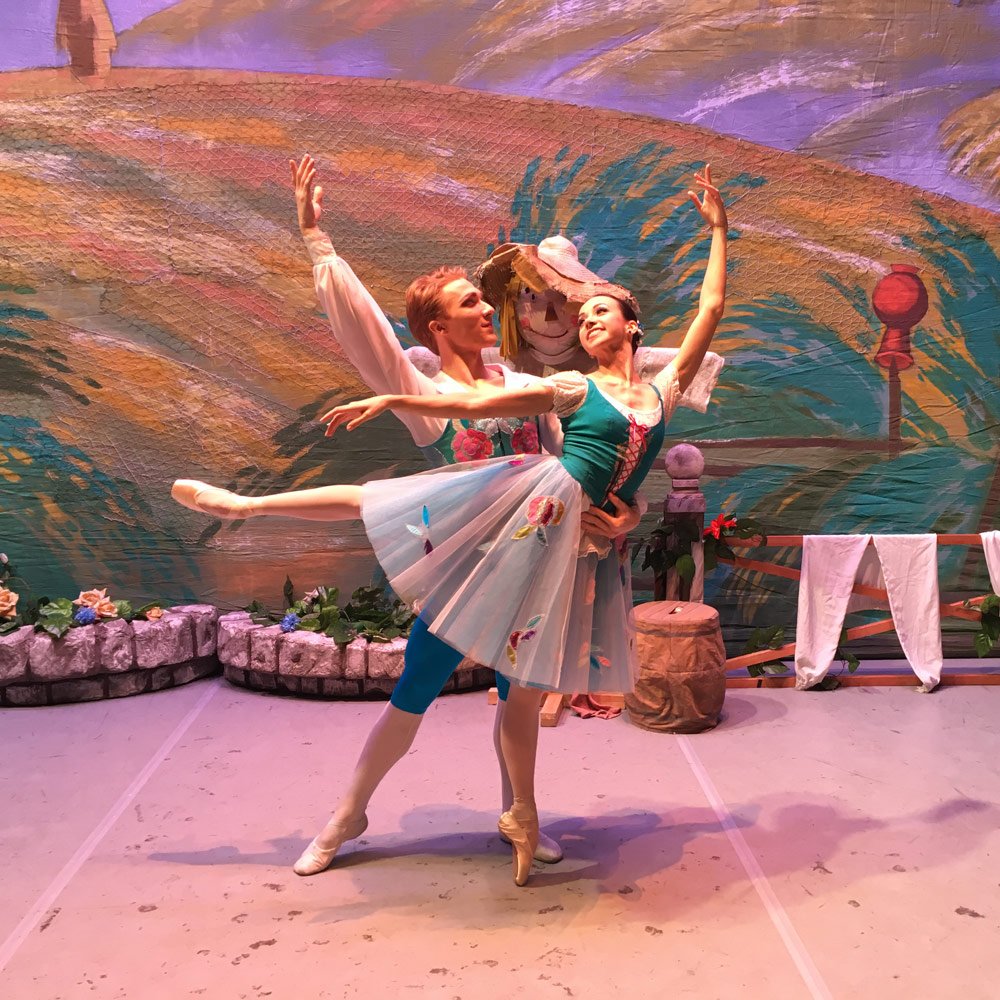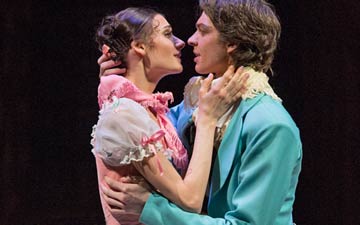
© Russian State Ballet of Siberia. (Click image for larger version)
Russian State Ballet of Siberia
La Fille mal gardée
★★★✰✰
Basingstoke, The Anvil
23 January 2017 (on tour to 15 February 2017)
en.krasopera.ru
Tour details on Raymond Gubbay site
This is the fifteenth tour of the United Kingdom by the Krasnoyarsk State Ballet from Siberia under its artistic director, Sergei Bobrov. Having started in Cardiff, the company of 38 dancers then performs in theatres across England, mostly for three nights, with a repertoire of Swan Lake, The Nutcracker, Coppélia, Giselle and La Fille mal gardée.
The version of Fille that they dance is based on the 1903 production by Alexander Gorsky, much modified over the years – most recently by Mark Peretokin, former director of the Siberian company. It is to a score by Paul Ludwig Hertel, commissioned by Paul Taglioni in 1864, with excerpts from other composers. Until Frederick Ashton created his Fille in 1960 to music by Ferdinand Hérold (arranged by John Lanchbery), most of the many productions of the ballet in Russia and around the world were to Hertel’s score. Ashton’s irresistible version to Hérold’s music is taking over, displacing earlier accounts at the Bolshoi, Paris Opera Ballet and American Ballet Theatre, among others.
So it’s intriguing to catch up with the Russian tradition of Fille, which draws on the original 1789 scenario, as Ashton’s version does, by the French choreographer Jean Dauberval. The revolutionary 18th century ballet, premiered in Bordeaux just days before the storming of the Bastille in Paris, featured country folk instead of aristocrats or mythical beings. Originally known as The Ballet of Straw, it has had several other titles, including The Vain Precaution and The Wayward Daughter. Productions have included live chickens on stage, as well as the Shetland pony Ashton introduced.

© Russian State Ballet of Siberia. (Click image for larger version)
The Siberian Ballet’s touring production features a hen house in Widow Simone’s farmyard, though only a few feathers appear on stage, along with eggs that naughty Lise is required to collect by her mother. There’s no butter churn, but there is a long ribbon for Lise’s playful encounter with her admirer, Colas. Their choreography, like that for their farmhand friends, is a combination of neat footwork and Soviet-style bravura feats for the principal dancers. Georgy Bolsunovsky as Colas, stocky and bouncy, resembles a jester with showy jumps and flashing manèges; Ekaterina Bulgotova as Lise performs fouéttés of all kinds, as well as a variation from Esmeralda, high-kicking her tambourine in between multiple pirouettes.
Gorsky’s choreography (if it is indeed all his) does not reflect the bucolic nature of the characters. Though there are some attractive set-pieces for Lise’s girlfriends, including a pas de huit resembling a Bournonville all-female ensemble, Lise could be any classical ballet heroine. The wedding pas de deux in Act II is often performed as a generic gala number, to music attributed to Hertel, Drigo and Johann Armsheimer. The male and female variations serve as ballet competition solos, with no reference to their context.
In Peretokin’s production for the Siberian Ballet, the first act leads up to a harvest festival in the farmyard, interrupted by a storm. Thomas, the rich owner of a vineyard, has arrived with his simpleton son, Alain and a purse full of gold for a marriage contract. Denis Pogorely as Alain, red-headed, freckled and gormless, has no more desire to be married to Lise than she does with him. She beats him up with a tin tray, while he takes consolation in his hobby-horse toy.
Widow Simone (Alexander Kuiimov) turns out to be not as stern as she looks, enjoying flirting with the villagers. She performs a Russian folk dance in the first act and a clog dance in the second (to the same Hertel music as Ashton’s Widow). The harvesters perform a maypole dance without a maypole at the centre and a jolly number with umbrellas during the rainstorm.

© Russian State Ballet of Siberia. (Click image for larger version)
The first act ends with the notary who has come to witness the signing of the marriage contract being made drunk by Colas’s friends. Colas steals his cap and gown so that he can enter, disguised, into the farmhouse in the second act. This may well be an innovation by Peretokin to avoid the provision of sheaves of wheat as a hiding place. Lise is locked in by her mother, who leaves her alone with the notary. Colas thus witnesses Lise’s ‘When I marry’ mime, to her embarrassment. Though the mime is charmingly done, it’s not as endearing as the longer version Ashton learnt from Tamara Karsavina, who knew it from dancing the Petipa/Ivanov Fille.
Colas and Lise are discovered behind a screen when Alain knocks it over in an exuberant solo with a butterfly net. Widow Simone faints in horror, Lise begs forgiveness, and a front cloth descends to cover the scene change for the eventual wedding celebrations.
Lots of dancing takes place, including Widow Simone’s clogging with four young men to escort and support her. Kuiimov, a merry soul, reveals that Simone has delusions of talent as well as of good looks. Pogorely shows off Alain’s dancing skills with multiple tours à la seconde while retaining his sublime air of innocence. Lise reappears in a tutu for the grand pas de deux, which Bulgutova and Bolsunovsky accomplish well enough. The choreography appears to have bits of every familiar classical ballet pas de deux linked together, soliciting applause after each tour de force.
The Siberian company performs its Fille mal gardée with good heart and neat feet. The characterisation is broad, as old-fashioned as the folk-art painted scenery by Dmitri Tcherbadzhi. Sets and dancers are prepared to accommodate different sized stages on tour, taking productions to theatres that are rarely visited by British ballet companies. Back home in Krasnoyarsk, the repertoire includes new works by Russian choreographers as well as the ‘classics’ the company brings to the UK each year.

















You must be logged in to post a comment.